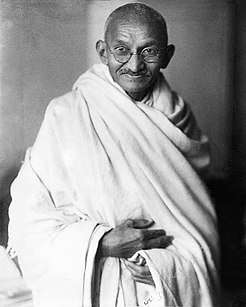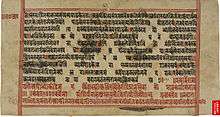Mahātmā
Mahātmā (/məˈhɑːtmə, -ˈhæt-/) is Sanskrit for "Great Soul" (महात्मा mahātmā: महा mahā (great) + आत्मं or आत्मन ātman [soul]). Mahātmā is similar in usage to the modern English term saint and can be translated to "ascended master".[1] This epithet is commonly applied to prominent people like Basaveshwara[2] (1105–1167), Mohandas Karamchand Gandhi (1869–1948), Munshiram (later Swami Shraddhananda) (1856–1926), Lalon Shah (1772–1890), Ayyankali (1863–1941), and Jyotirao Phule (1827–1890). It has also been historically used for a class of Jain scholars.

Mohandas Gandhi's title "Mahatma"
According to some authors, Rabindranath Tagore is said to have used this title for Gandhi on 6 March 1915.[3] Some claim that he was called Mahatma by the residents of Gurukul Kangadi in April 1915,[4] and he in turn called the founder Munshiram a Mahatma (who later became Swami Shraddhananda). However, a document honoring him with the title "Mahatma" on 21 January 1915, in Jetpur, Gujarat, by Nautamlal Bhagvanji Mehta is preserved at the National Gandhi Museum in New Delhi, India.[5] This document remains the earliest record of the title "Mahatma" being bestowed upon Gandhi. The use of the term Mahatma in Jainism to denote a class of lay priests, has been noted since the 17th century. A Mahatma is someone who practices Trikaranasuddhi.[6]
Theosophy
The word, used in a technical sense, was popularized in theosophical literature in the late 19th century, when Madame Helena Blavatsky, one of the founders of the Theosophical Society, claimed that her teachers were adepts (or Mahatmas) who reside in Asia.
According to the Theosophical teachings, the Mahatmas are not disembodied beings, but highly evolved people involved in overseeing the spiritual growth of individuals and the development of civilizations. Blavatsky was the first person in modern times to claim contact with these Adepts, especially the "Masters" Koot Hoomi and Morya. Alvin Boyd Kuhn wrote about mahātmās:[7]
The Masters whom Theosophy presents to us are simply high-ranking students in life's school of experience. They are members of our own evolutionary group, not visitants from the celestial spheres. They are supermen only in that they have attained knowledge of the laws of life and mastery over its forces with which we are still struggling.
In September and October 1880, Blavatsky visited A. P. Sinnett at Simla in northern India. Sinnett wrote The Occult World (1881) and Esoteric Buddhism (1883).
There has been a great deal of controversy concerning the existence of adepts. Blavatsky's critics have doubted the existence of her Masters. See, for example, W. E. Coleman's "exposes".
After Blavatsky's death in 1891, numerous individuals have claimed to be in contact with her Adept Teachers. These individuals have stated that they are new "messengers" of the Masters and they have conveyed various esoteric teachings.[8] Currently, various New Age, metaphysical, and religious organizations refer to them as Ascended Masters, although their character and teachings are in several respects different from those described by Theosophical writers.[9][10]
Divine Light Mission
The Divine Light Mission (DLM) was a Sant Mat-based movement begun in India in the 1930s by Hans Ji Maharaj and formally incorporated in 1960. The DLM had as many as 2,000 Mahatmas, all from India or Tibet, who taught the DLM's secret meditation techniques called "Knowledge". The Mahatmas, called "realized souls",[11] or "apostles", also served as local leaders.[12] After Hans Ji's death in 1966 his youngest son, Prem Rawat (known then as Guru Maharaj Ji or Bagyogeshwar), succeeded him. The young guru appointed some new Mahatmas, including one from the United States. In one incident, a prominent Indian Mahatma nearly beat a man to death in Detroit for throwing a pie at the guru.[13] In the early 1980s, Prem Rawat replaced the Divine Light Mission organization with the Elan Vital and replaced the Mahatmas with initiators. The initiators did not have the revered status of the Mahatmas, and they were drawn mostly from Western followers.[11] In the 2000s, the initiators were replaced by a video in which Rawat teaches the techniques himself.
In popular culture
W.C. Fields used the pseudonym Mahatma Kane Jeeves when writing the script for The Bank Dick (1940), in a play on both the word "Mahatma" and a phrase an aristocrat might use when addressing a servant, before leaving the house: "My hat, my cane, Jeeves".
Jain Mahatmas

Among the Jains the term Mahatma is used for the class for scholars who are householders.
Mahatma Hirananda of Mewad
The Mewad Ramayana[14] described as "one of the most beautiful manuscripts in the world"[15] has been digitally reunited after being split between organizations in the UK and India for over 150 years, by the British Library and CSMVS Museum in Mumbai. The colophon states that the text, commissioned by Acarya Jasvant for the library of Maharana Jagat Singh I of Mewar, was written by the Mahatma Hirananda, was finished on Friday 25 November 1650.[16] Mahatma Hirananda being a Jain scribe, incorporated traditional Jain scribal elements into the manuscript.[17]
Jain Mahatmas in the Dabestan-e Mazaheb
The famous Dabestan-e Mazaheb often attributed to one Mohsin Fani, written around 1655 CE. is a text written in the Mughal period that describes various religions and philosophies the author encountered.[18] Its Section 11 is dedicated to Jainism. It states: "Similar to the dervishes of both classes (Monk and Jatis) is a third sect, called Mahá-átma; group separated from the Oswal Jains, have the dress and appearance of Jatis; however, do not pluck their hair with tweezers, but cut it. They live the social life and spread the teaching of Mahavir and other Jain Trithankar in the society. They accumulate money, cook their meal in their houses, drink cold water, and take to them a wife." The term Mahatma was thus used for priests/scholars who were not celibate. The present Persian edition of the text by Rezazadeh Malik attributes it to the son and successor of Azar Kayvan, 'Kay Khosrow Esfandiyar'.
Criticism
K. Paul Johnson in his books[19] speculates that the "Masters" that Blavatsky wrote about and produced letters from were actually idealizations of people who were her mentors. Aryel Sanat,[20] author of The inner life of Krishnamurti: private passion and perennial wisdom, wrote that Johnson "claims in all of his books that there were no Masters at all in early [Theosophical Society] history, & that [Helena Blavatsky] invented them (as others had claimed she had invented her travels)." Sanat wrote that Johnson "deliberately ignores the main sources of evidence for their real physical existence."[21] What Sanat thought these were is not made quite clear.
Sources
- French, Brendan James (2000) The theosophical masters: an investigation into the conceptual domains of H.P. Blavatsky and C.W. Leadbeater. Ph.D. thesis, University of Sydney, Department of Religious Studies. Sydney.
- Johnson, K. Paul (1994) The Masters Revealed: Madam Blavatsky and Myth of the Great White Brotherhood. Albany, New York: State University of New York Press.
- Johnson, K. Paul (1995) Initiates of Theosophical Masters. Albany, New York: State University of New York Press.
- Kalnitsky, Arnold (2003) The Theosophical Movement of the Nineteenth Century: The Legitimation of the Disputable and the Entrenchment of the Disreputable. University of South Africa. Dissertation: 443 pp.
- Kuhn, Alvin Boyd (1930) Theosophy: A Modern Revival of Ancient Wisdom. Ph.D. Thesis. Whitefish, Montana: Kessinger Publishing. ISBN 978-1-56459-175-3.
Footnotes
- Gilman, D. C.; Peck, H. T.; Colby, F. M., eds. (1905). . New International Encyclopedia (1st ed.). New York: Dodd, Mead.
- "PM's address on the occasion of release of Commemorative Coin in honour of Mahatma Basaveshwara : Speeches : Prime Minister of India – Dr. Manmohan Singh (May 22, 2004 – 26th May 2014)". archivepmo.nic.in. Retrieved 7 August 2018.
- Dutta, Krishna and Andrew Robinson, Rabindranath Tagore: An Anthology, p. 2
- और इस तरह गांधी महात्मा बन गए, 01-Oct-2012
- National Gandhi Museum, New Delhi; KamdarTree.com
- Sankar R N, Ajith (July–December 2012). "Ascertaining Linkages between Trikaranasuddhi and 'Tapping Spirituality as the Context of Leadership'". IPE Journal of Management. 1 (2): 81–105. SSRN 2212138.
- Kuhn (1930), – p. 147.
- Madame Blavatsky & the Latter-Day Messengers of the Masters.
- Leadbeater, C. W. The Masters and the Path. Adyar, India: Theosophical Publishing House, 1929 (Reprint: Kessinger Publishing, 1997).
- Partridge, Christopher ed. New Religions: A Guide: New Religious Movements, Sects and Alternative Spiritualities Oxford University Press, USA 2004.
- Price, Maeve (1979): The Divine Light Mission as a social organization. (1) Sociological Review, 27, Page 279-296
- Levine, Saul V. in Galanter, Marc (1989). Cults and New Religious Movements: A Report of the American Psychiatric Association. American Psychiatric Pub., Inc. ISBN 0-89042-212-5.
- Bartel, Dennis (November 1983). "Who's Who in Gurus". Harper's. p. 55.
- In pictures: Stunning Ramayana manuscript goes digital, BBC, 21 March 2014
- The Mewar Ramayana at the British Library: How the complete digital version came to be
- Ramayana – Pages 21 and 22 (British Library Add MS 15296-15297 and IO San 3621)
- Ramayana – Pages 3 and 4
- The Dabistán: Or, School of Manners: The Religious Beliefs, Observances, Philosophic Opinions and Social Customs of the Nations of the East, Fani Muhsin, Translated by David Shea, Anthony Troyer, Publisher, M. Walter Dunne, 1901 p. 275-276
- Johnson (1994), Johnson (1995) – p. 49.
- "Aryel Sanat (Miguel Angel Sanabria) is currently Adjunct Professor in the Department of Philosophy and Religion at the American University in Washington, D.C." // About the author of The inner life of Krishnamurthy in 1999.
- See Theosophy World.
References
- Dutta, Krishna, and Andrew Robinson. Rabindranath Tagore: An Anthology. Picador/Macmillan: London, 1997.
See also
- Ascended masters
- Initiation (Theosophy)
- Theosophy
- Alice A.Bailey
- Helena Petrovna Blavatsky
- Helena Roerich
- Benjamin Creme
External links
| Wikisource has the text of the 1905 New International Encyclopedia article Mahātma. |